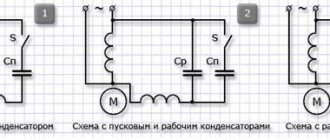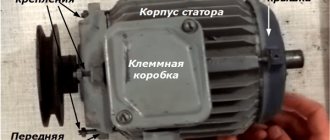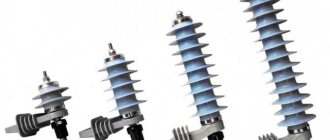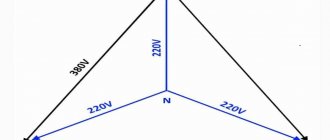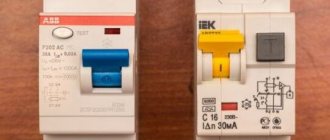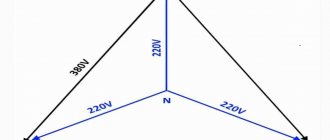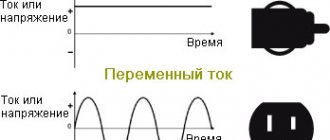The danger of fire from short circuit current, electrical injury caused by the appearance of a current load on the housings of household appliances, according to the “Rules for Electrical Installations,” requires protection by special devices mounted in the home electrical circuit. Automatic circuit breakers (CBs) for current load and RCDs (residual current devices) successfully cope with the function of ensuring electrical safety. However, when installing devices in previously installed electrical panels, problems arise due to lack of space. For such cases, difavtomats (abbreviated as “diffs” or abbreviated as RCBOs) are used, which combine the functions of a circuit breaker and an RCD in one housing. What is a differential machine, the features of this device are described in this article.
Operating principle and design of the automatic machine
In a dielectric housing, consisting of two parts, the elements of the RCD and the circuit breaker are located separately from each other, each in a specially designated place. A schematic diagram of how a typical differential machine works is shown in the image:
The modular circuit breaker unit consists of thermal and electromagnetic releases. The bimetallic plate of the thermal release is triggered by heating with an overload current, and the solenoid core of the electromagnetic release, by its movement, opens the circuit in the presence of a short circuit.
Another modular unit monitors the appearance of a current load, performing tasks solved by the RCD. Its main element is a differential transformer, in which, under normal operating conditions, the current of the primary winding is equal to the current of the secondary (the only difference is the direction vector). When a person touches, for example, a conductor with broken insulation, part of the current will not return through the secondary winding, but will go through the person to the ground. On it, due to a change in the magnetic flux, a voltage will be induced, which, when it reaches a certain value, sends a signal to the opening relay.
Consequences of mistakes made
The most common connection errors that can cause significant damage are:
- connecting the working neutral conductor to a similar element of the protection conductor or an open part of the electrical installation leads to the fact that the RCD will not function;
- the device will be operated in false alarm mode if the rules for connecting the grounding and neutral conductors in sockets are violated;
- an open-phase connection also triggers the RCD due to the fact that its load is connected to the neutral working conductor;
- violation of polarity during installation causes currents to flow in only one direction;
- uncontrolled shutdowns of the device occur when there are errors in the connection of the neutral conductors for a pair of RCDs;
- incorrect connection of phases and neutrals taken from different devices will cause problems when connecting a load with a neutral conductor that belongs to another RCD.
Source: uelektrika.ru
Main technical characteristics
In order not to make a mistake in choosing a difavtomat, you should be guided by the main technical characteristics. They represent varieties of parameters related to both circuit breakers and RCDs.
- Rated or operating voltage for single-phase or three-phase networks.
- The operating current, with its magnitude, the protective device is capable of operating for a long time.
- Instantaneous tripping current of the electromagnetic release. The “time-current” characteristics of difavtomats depend on the design of the device’s circuit breaker; they are mainly of types B, C, and D.
- Differential leakage current - shows the value at which the protection device will trip to disconnect the circuit.
- The differential reacts to the specific nature of the current source, which can be sinusoidal, pulsating or constant.
- According to the operating principle of the RCD actuator on differentials, it can be electronic or electromechanical.
- The differentials are performed with different response delays. The protective devices at the input have a longer time delay than those installed after the input. This selectivity creates the opportunity for the latter to operate the protective shutdown.
- The design of most differentials includes testing the RCD for operability, which is why there is a “TEST” button.
Protection against electric shock using a differential circuit breaker
Modern society is characterized by the widespread use of a variety of electrical equipment. There are often cases when newly purchased equipment is connected to wiring that is not designed for high current consumption.
Another situation: instead of expensive devices from well-known manufacturers, in order to save money, designs from little-known brands are purchased. Unscrupulous manufacturers reduce the cost of products to the detriment of quality. In order to increase human safety and prevent fires, a variety of protection devices have been developed.
Marking
The image shows the main letter and number symbols that are present for marking most difavtomats.
In the image, the residual current circuit breaker is designated by the abbreviation AVDT 63, where the numbers indicate the rated current of the device 63 A. The manufacturer's brand is indicated at the top. Below is the type of design of the RCD (here electronic).
Non-standard verification options
It should be noted that the check does not apply to circuit breakers; it only applies to devices that respond to current leakage (RCD). To check for overload currents and short circuits, you need a laboratory option; this cannot be done at home.
In addition to the standard one, using a button, there are other ways to check the automatic machine.
- Check the differential machine in the usual way using a battery. The connection diagram is simple: the positive contact of the battery is connected to the input contact, the negative contact to the output:
By closing the contacts on the poles of the machine, we thereby create a magnetic disturbance on the windings of the differential transformer and the shutdown mechanism of a working differential is triggered. An effective way to choose a differential machine when buying it in a working condition in a store. - Checking functionality with a magnet. You should bring the magnet closer to the cocked RCBO - the differential protection device should turn it off.
Important: The RCD must operate under the influence of an electromagnetic field; this testing principle is not suitable for an electronic device.
- Selected resistance value. The resistance that is connected between the socket and the grounding device is determined using Ohm’s law, well-known in electrical engineering, R = U/I, where U is the input voltage (220 V or 380 V), I is the leakage current indicated on the circuit breaker. The resistance calculated in this way will cause a leakage current, at which it knocks out the automatic switch. By connecting a multimeter in series to the circuit and setting the operating mode to “ammeter”, you can monitor the circuit current readings.
- Electronic devices. The use of multifunctional electronic measuring instruments connected via a socket allows you to check several parameters of the automatic machine at once. In addition to determining operability, you can find out the response time and make sure that the leakage current value indicated on the body of the protective device is correct. However, it will be an expensive pleasure for the home.
Designation of a difavtomat in a conventional form on a single-line diagram
“Rules for the technical operation of consumer electrical installations” regulate the creation of technical documentation that is as convenient as possible to use. One of them is a single-line diagram in a simplified form showing the connections of power lines, distribution points and the location of other electrical elements. So, there is no designation of a difavtomat on the diagram that corresponds to the regulatory documentation. With the tacit consent of users, they are designated as follows:
The letter designation of the differential machine in the diagram is in the form of Latin letters QF.
Criterias of choice
The main criterion for choosing a difatomat for an apartment will be its ability to provide the energy consumed by all electrical appliances. How to choose a difavtomat by power, whether one is enough or installing several will be shown by calculating the electricity consumption of household electrical appliances, taking into account the real time of their operation. As initial data, you can use information from technical data sheets or calculate according to the data indicated on the device body.
In addition to the calculation-related option, you can measure the power of a household electrical device using an energy meter. Why is it plugged into a socket, and why is the device itself connected to it? It will be labor-intensive, but simple, to put one device into operation for an hour at a time. By taking readings from the electric meter, we will get the necessary information. Choose a RCBO with technical characteristics corresponding to the calculated data.
The high reliability of operation of difavtomats is guaranteed by belonging to a brand that has won the trust of consumers with the impeccable quality of its products.
Foreign manufacturers include: Swedish-Swiss ABB, French LeGrand, Schneider Electric, German Siemens and others.
Among Russian manufacturers, the quality of which is inferior to those presented above includes the brands KEAZ, IEK, DEKraft and others.
Studying the ratings that are available on the Internet will help you choose which brand to choose.
Errors when purchasing
The main mistake when buying a automatic rifle is the desire to protect yourself. In this connection, consumers choose devices with minimal current protection and overload. As a result, numerous false positives are observed.
Exceeding the shutdown current does not guarantee reliable shutdown at high load currents.
Competent selection of automatic protection parameters is usually carried out by specialists, who also give recommendations on the distribution of electrical circuits and the installation of a power panel. The lack of proper qualifications does not guarantee normal protection of consumers from emergency situations.
Advantages and disadvantages
The positive characteristics of difavtomats include the following.
- The fire safety of objects is increased - there is protection against overheating of electrical wiring.
- There is no need to install an RCD; its functions are performed by a similar device integrated into the differentials.
- It takes up minimal space in the input panel; single-module differential blocks are all compactly mounted on its DIN rail.
- Due to the reduction of contact groups, it is easy to install.
The device also has negative characteristics.
- Multifunctionality creates problems in determining the cause of the operation - from a short circuit or from a leakage current. Not all automatic machines are equipped with special indicators, the purpose of which is to indicate the designation of the critical factor. This makes it difficult to find, and therefore troubleshoot, the damaged section of the circuit.
- The failure of one of the components - a circuit breaker or RCD - leads to the replacement of the entire, inexpensive device itself. Economically, installing a separate RCD and circuit breaker is more profitable.
- It should be taken into account that electronic automatic devices lose their functionality if the neutral wire breaks. Attention: if the phase is energized, this may result in electric shock to a person. The electromechanical version of the difavtomat does not have this drawback.
Connection in a single-phase network
In such a situation, the ideal choice is two-pole single-phase RCDs. Let's look at the most common scheme for devices of this type.
The connection points for zero N and phase La, as well as the main markings, are located on the device itself and in the passport. The maximum permissible currents on machines can never exceed the settings of the protection device, because it does not provide a current limit. Negligence in connecting zero and phase can, at best, lead to a basic lack of power, and in some cases causes the breakdown of the protective device.
The opinion of experts is unanimous - in a single-phase network, the RCD switching circuit should be as close as possible to the meter and located next to the power source.
